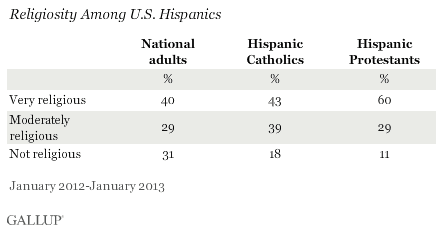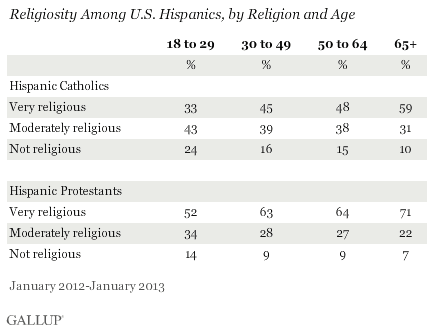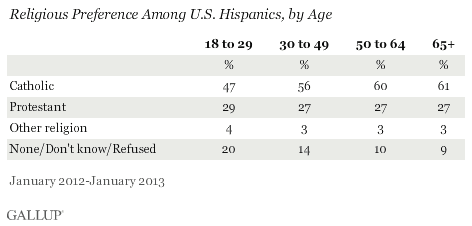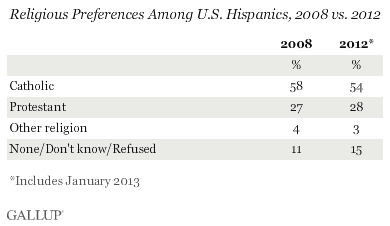PRINCETON, NJ -- Although the majority of Hispanics in the U.S. are Catholic, the smaller group of Hispanics who are Protestant are significantly more likely to be very religious (60%) than those who are Catholic (43%).

This analysis is based on more than 360,000 Gallup Daily tracking interviews conducted from January 2012 through January 2013, including 28,607 interviews with Hispanics. The religious characteristics of Catholics, including those in the United States, are of particular interest as the election of a new Pope begins with the announced resignation of Pope Benedict XVI.
Overall, 40% of Americans nationwide are very religious based on respondents saying religion is an important part of their daily life and that they attend religious services every week or almost every week. Thirty-one percent of Americans are not religious, saying religion is not an important part of their daily life and that they seldom or never attend religious services. The remaining 29% of Americans are moderately religious, saying religion is important in their lives but that they do not attend services regularly or that religion is not important but that they still attend services.
The substantial difference in the religiosity of Catholic and Protestant Hispanics is reflective of a pattern found in the U.S. population overall. Fifty-one percent of all Protestants, including those who identify themselves as Christian but not Catholic, are very religious, compared with 43% of all Catholics. But this eight-percentage-point gap among all Americans expands to 17 points among Hispanics, primarily because Hispanic Protestants are significantly more religious than all Protestants in the U.S. Hispanic Catholics, on the other hand, are no more religious than the general Catholic population.
Protestant-Catholic Gap in Religiousness Evident Among Hispanics of All Ages
The religiousness gap between Protestant and Catholic Hispanics is evident across all age groups. The percentage of 18- to 29-year-old Hispanic Protestants who are very religious is 19 points higher than Catholic Hispanics of the same age. Among Hispanics who are 65 and older, the Protestant-Catholic gap is 12 points.

Older Hispanics More Likely to Be Catholic
Catholics in the U.S. today are suffering from an identity shortfall among Hispanics younger than the age of 30. Less than half of 18- to 29-year-old Hispanics are Catholic, significantly lower than the percentage Catholic among those aged 30 and older. This is particularly noteworthy as there is no shortfall of Protestants among young Hispanics compared with older age groups: The Protestant percentage is almost identical across all age groups. Younger Hispanics, as is the case in general in the U.S. population, are less likely to have any religious identity at all. This tendency of the youngest Hispanic Americans to be "nones" -- without an explicit religious identity -- thus appears to come at the cost of Catholic identity and not Protestant identity.

Younger Americans in general tend to become more religious as they age through their 30s. Assuming that this pattern holds for today's young Hispanics as they get older, the question becomes whether they will adopt the Catholic identity that is more prevalent among their elders, or if their disproportionate tendency to be Protestant will continue in to their older years. If the latter pattern holds, then Hispanics as a whole will become less Catholic in the decades ahead.
In fact, Hispanics have become less likely to identify as Catholic over the past five years, while the percentage saying they are Protestant has stayed roughly the same.

Overall, the finding that younger Hispanics are proportionately more Protestant and that all Hispanics are becoming proportionately more Protestant over time suggest that the percentage of Hispanics who are Catholic may continue to slip in the years to come. As noted, this will be particularly true if today's young Hispanics maintain their proportionally higher Protestant identification.
Implications
A majority of Hispanics in America continue to identify as Catholic, although the Catholic percentage among Hispanics appears to be decreasing and the youngest Hispanics in America today are less likely to be Catholic than those who are older. Additionally, those Hispanics who are Catholic are much less religious than those who are Protestant.
The percentage of Hispanics who are Protestant is, on the other hand, consistent across age groups and has been stable since 2008.
These patterns suggest the potential for an increase in the relative or proportionate number of Protestant Hispanics in the years ahead. If this does happen, and given that Protestant Hispanics are considerably more religious than Catholic Hispanics, this could lead to a higher average level of Hispanic religiosity in future years.
Survey Methods
Results for this Gallup poll are based on telephone interviews conducted January 2012-January 2013, on the Gallup Daily tracking survey, with a random sample of 28,607 Hispanics, aged 18 and older, living in all 50 U.S. states and the District of Columbia.
For results based on the total sample of Hispanics, one can say with 95% confidence that the margin of sampling error is ±1 percentage point.
Interviews are conducted with respondents on landline telephones and cellular phones, with interviews conducted in Spanish for respondents who are primarily Spanish-speaking. Each sample of national adults includes a minimum quota of 50% cellphone respondents and 50% landline respondents, with additional minimum quotas by region. Landline telephone numbers are chosen at random among listed telephone numbers. Cellphones numbers are selected using random digit dial methods. Landline respondents are chosen at random within each household on the basis of which member had the most recent birthday.
Samples are weighted to correct for unequal selection probability, nonresponse, and double coverage of landline and cell users in the two sampling frames. They are also weighted to match the national demographics of gender, age, race, Hispanic ethnicity, education, region, population density, and phone status (cellphone only/landline only/both, cellphone mostly, and having an unlisted landline number). Demographic weighting targets are based on the March 2012 Current Population Survey figures for the aged 18 and older U.S. population. Phone status targets are based on the July-December 2011 National Health Interview Survey. Population density targets are based on the 2010 census. All reported margins of sampling error include the computed design effects for weighting.
In addition to sampling error, question wording and practical difficulties in conducting surveys can introduce error or bias into the findings of public opinion polls.
For more details on Gallup's polling methodology, visit https://www.gallup.com/.
